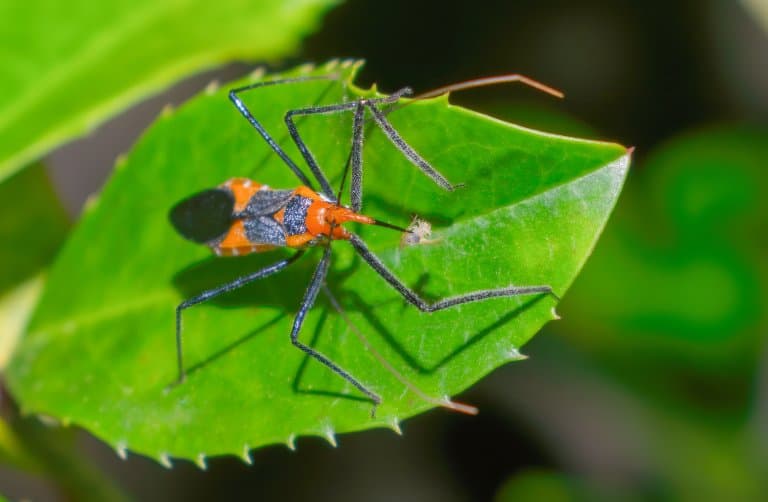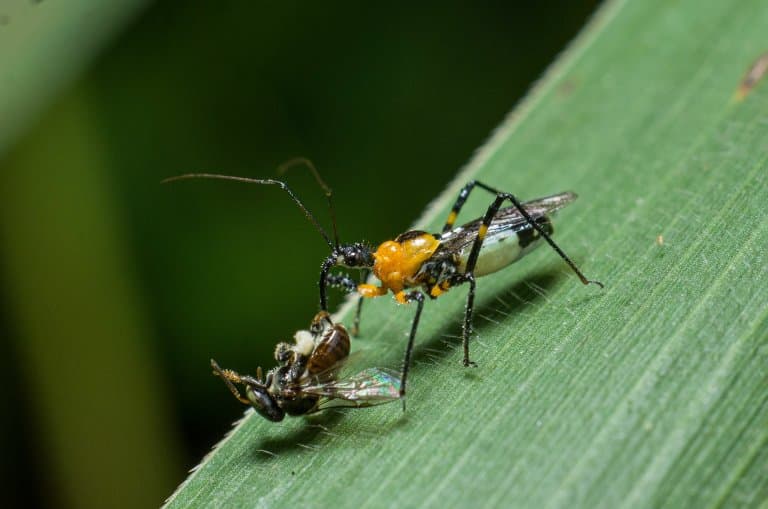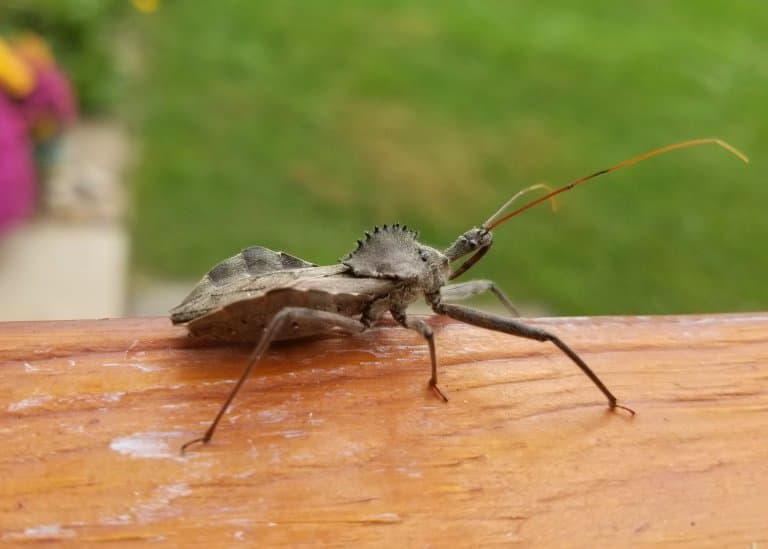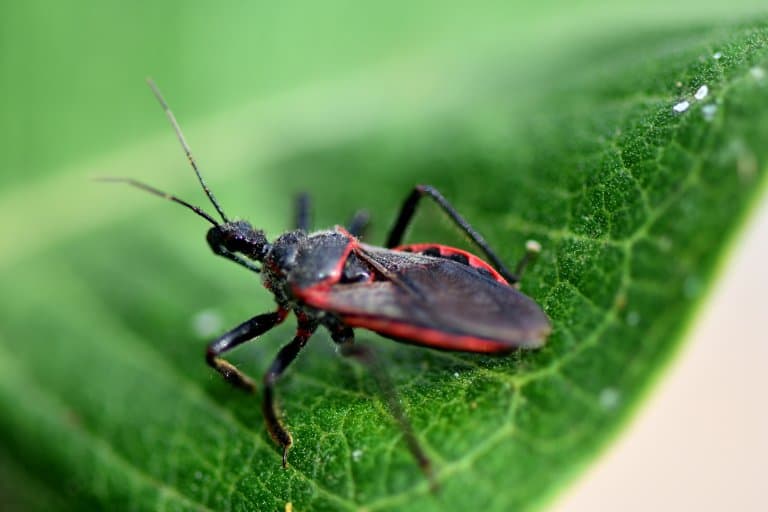Assassin Bug Profile
The word “bug” gets thrown around with reckless abandon in the non-entomology world, but it does have a true meaning in zoology: a true bug is from the order Hemiptera and is characterised by its piercing mouthparts and often shield-shaped body.
Most bugs are plant suckers like aphids, but some feed on blood, such as bedbugs. Then there’s the family Reduviidae, known as assassin bugs – which use their mouthparts to eliminate political adversaries.

Assassin Bug Facts Overview
| Habitat: | Grasslands, forests and more |
| Location: | Worldwide |
| Lifespan: | 6-10 months |
| Size: | Up to about 3.3cm (1.5 inch) |
| Weight: | <1g |
| Colour: | Varied |
| Diet: | Invertebrates |
| Predators: | Birds, bats, reptiles, small mammals, insectivores |
| Top Speed: | Slow |
| No. of Species: | 7,000 |
| Conservation Status: | N/A |
There’s around 20 recognized subfamilies of assassin bugs, with 7,000 different species.
While most subfamilies are just referred to as ‘assassin bugs’, some subfamilies and specific genus have other common names, that include –
- Ambush bugs (Phymatinae)
- Thread-legged bugs (Emesinae)
- Kissing bugs (Triatominae)
- Wheel bugs – (Arilus)
- Grass assassin bugs (Lopodytes)
Assassin bugs are one of the few predatory hemipterans that are land-based.
They’re notorious biters with a chemical injection designed to make killing and feeding easier. The remarkable tool used to administer this is also used to scream at their enemies.
For the most part, these are harmless insects, capable only of giving a bit of a nasty nip.
In other cases, though, they can be very dangerous vectors of disease and cause some uncomfortable allergies to boot.
Interesting Assassin Bug Facts
1. They’re biters
All bugs bite one thing or another, but almost all predatory bugs live in the water, which makes assassin bugs unusual still.
As bugs, these are real suckers. A long, rigid proboscis hides under the insect’s head, ready to unfold and impale unsuspecting prey.
In most cases, this is a caterpillar or a small beetle, but sometimes it’s the young of a rival species!

2. Their proboscis is sheathed
Once they’re done slaughtering their enemies, that formidable piercing lance returns to its folded position, like a flick knife, under the head of the bug.
It’s protected by a stiff sheath that not only keeps it sharp but also helps it talk.
3. They can use it to sing
Assassin bugs are capable of stridulation. This is a form of noise-based communication that can be accomplished by rubbing two stiff bits of insect together.
Crickets, cicadas, and even longhorn beetles make sound this way, and as it happens, so do assassin bugs.
While most insects use stridulation as a loving call to a potential mate, this would be uncharacteristic of a warrior race like the assassin bugs; instead, it seems to be primarily a defence sound and is thought to occur as a result of a specially grooved sheath.
The sound is made by rasping the proboscis against ridges in this groove stridulitrum (stridulatory organ). These sounds are often used to discourage predators.
4. Some have wheels
One of the most common submissions for ‘What is this bug’ on the subreddit with the same name is a form of assassin bug with a Mad Max-style armoured wheel protruding from its thorax.
The so-called “wheel bug” is one of the more terrifying examples of an assassin bug. It’s one of the largest of the assassins and has raptorial, gripping front legs like a praying mantis. And, of course, the death spear between them.
Fortunately for us, this is a bug that eats a lot of the things we don’t like. Crop pests are a primary food source for the wheel bug, so it’s a useful critter to have around, as long as you don’t get on the wrong side of it. 1

5. They’re also venomous!
Despite arthropods being well known for their dangerous venoms, there are very few venomous biting insects. Spiders are arachnids, centipedes are in a world of their own, and almost all the venomous insects around administer it via a sting.
Assassin bugs, however, back up their terrifying puncture attack with a healthy dose of insect venom. This venom is paralytic and lethal to invertebrates and contains a bunch of scary toxins associated with the liquefaction of soft tissues.
That means, after biting into a prey item and injecting its venom, the assassin bug turns it into a beetle smoothie and sucks it up with a straw. 2
6. Not all are predators though
You’ll be pleased to learn some are just blood-sucking parasites, so that’s nice.
Kissing bugs, for example, are adorable little face-biters that feed on vertebrate blood.
If you’re reading this, you’re likely a vertebrate, and therefore a target! And you may have heard of the kissing bug for some of the horrible things it brings along with it. 3
7. They can cause disease
So, once you’re asleep, these kissing bugs will clamber onto your face and start biting you, feeding on your blood. But that’s not the worst of it.
The disease they spread, called Chagas Disease, is passed on via the poop of the kissing bug… when it goes into your eyes.
After a long, hearty snack on your face blood, this lovely bug takes a crap in your eye on the way out. If that faeces happens to contain any of the parasites Trypanosoma cruzi, you’re possibly out of luck.
However, in most cases, even with the parasite present, it’s not adapted to live in humans, and infection doesn’t occur. Instead, you only get the poop. Or, if you’re very unlucky, an anaphylaxic reaction to their saliva. 4

8. Some are very sneaky
Many assassin bugs are ambush predators, others slowly stalk their prey. One species even steps carefully over the sticky traps of carnivorous plants to feast on the ensnared dead and dying caught within.
But at least one species uses cunning to kill their prey. Ptilocnemus lemuri specialises in hunting ants, and it does this with a bit of trickery.
As the aggressive ant discovers the assassin, it prepares to kill the bug to bring it home. It’s thought the assassin has a chemical pheromone attractant that brings ants to where it stands.
Upon biting the leg of the assassin bug, the ant has no time to remove itself as the bug spins around and impales it on the death spike. Bursting into the ant through a weak point in its armour, the proboscis is then lifted, ant attached, and jerked around to work the venom in. 5
9. Kissing bugs are one of the most deadly animals in the world
In Central and South America, the parasite that causes Chagas disease from kissing bugs is thought to be responsible for as many as 10,000 deaths each year.
This puts kissing bugs into our top 10 deadliest animals in the world list.
It is estimated that as many as 8 million people in Mexico, Central America, and South America have Chagas disease, most of whom do not know they are infected.
However, symptoms can include fever, fatigue, body aches, and swelling at the site of infection. Without medical attention, individuals can experience heart failure and neurological disorders. 6
Assassin Bug Fact-File Summary
Scientific Classification
| Kingdom: | Animalia |
| Phylum: | Arthropoda |
| Class: | Insecta |
| Order: | Hempitera |
| Family: | Reduviidae |
Fact Sources & References
- “The Wheel Bug”, College of Agriculture Food and Environment.
- Andrew A. Walker, “Melt With This Kiss: Paralyzing and Liquefying Venom of The Assassin Bug Pristhesancus plagipennis (Hemiptera: Reduviidae)”, Science Direct.
- “Parasites – American Trypanosomiasis (also known as Chagas Disease)”, Centers for Disease Control and Prevention.
- John H. Klotz (2010), “Kissing Bugs”: Potential Disease Vectors and Cause of Anaphylaxis”, Oxford Academic.
- “Feather-legged assassin bug”, Picture Insect.
- Global Health, Division of Parasitic Diseases and Malaria (2022), “Parasites – American Trypanosomiasis (also known as Chagas Disease)“, Centers for Disease Control and Prevention.
